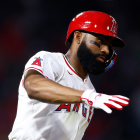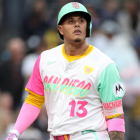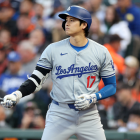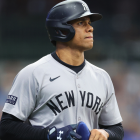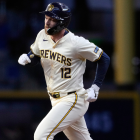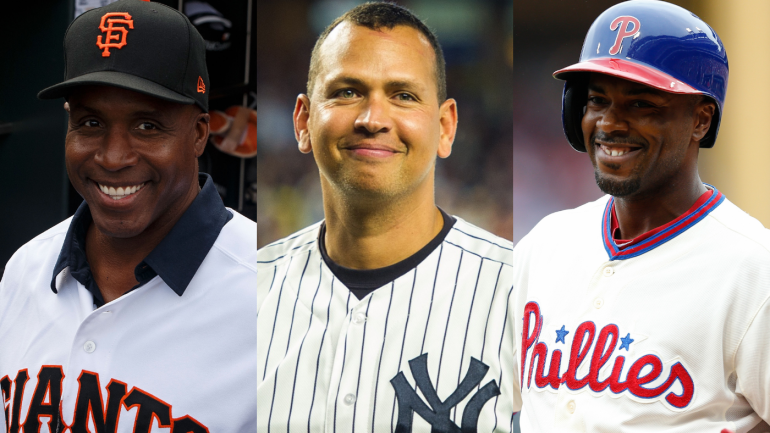
The 30-player ballot for the 2022 BBWAA Hall of Fame class was revealed on Monday and with it comes the obligatory Internet Discourse. I'm here for it. I might be in the minority, but I love Hall of Fame arguments.
As a reminder on the process, each year the BBWAA (Baseball Writers' Association of America) votes on a Hall of Fame class from a set of former players who qualify to be on the ballot. Those players have either been placed on the ballot by the Hall of Fame (chosen from a group of players with a minimum of 10 years in the majors) or are holdovers from years' past.
The holdovers had to have received at least five percent in the previous vote. A player can only remain on the ballot for 10 years. If he's not voted in for those 10 years, he'll fall off the ballot. Those who don't get at least five percent of the vote also fall off. Those who get at least 75 percent of the vote get into the Hall of Fame. Voters can only select a maximum of 10 players and there is no minimum (yes, ballots can be and have been sent back blank).
Here are some storylines to watch this winter as we discuss the Hall of Fame leading to the announcement in mid-January.
A final note: I'm not going to dive deep on cases for or against any of the legitimate candidates here. We have weeks for that. This will simply be an analysis of the ballot and the storylines that come with it.
1. One last shot for polarizing quartet
With Curt Schilling, it'll probably be best for everyone when this is over. He seems to want to not get voted in by the baseball writers, whom he referred to as "spineless cowards" last year.
Schilling got 71.1 percent of the vote last year, his highest mark yet (he got 38.8 percent in 2013, before he was really vocal on politics, so his self-victimization is absurdly misplaced), but he also wrote a letter to the Hall asking that he be removed from the ballot while attacking the same group of voters that saw over 70 percent attempt to vote him in.
My stance remains that Schilling was a Hall of Fame player. He hasn't stayed out of his own way since and it seems to be by design, for whatever reason. We'll see how it all unfolds in January. The good news is this is the last time we'll be discussing it. It's Schilling's 10th year.
Barry Bonds and Roger Clemens are forever tied together, so it's a bit poetic that they head into their 10th and final season on the ballot together. Bonds got 61.8 percent of the vote last year while Clemens got 61.6. There isn't much to discuss here. They both posted 100th percentile statistical playing careers but are connected to PEDs without ever having been suspended under the current testing policy that was implemented before they retired. No one is a "maybe" here and most of our minds are made up.
But it is the last time, so it remains a huge storyline.
And then there's Sammy Sosa. He's on the ballot for a 10th time merely as a formality at this point. He only got 17 percent of the vote last year.
2. Hello, A-Rod and Big Papi
As if the last-year names above weren't enough to get the juices flowing ...
Alex Rodriguez and David Ortiz are now on the ballot for the first time.
A-Rod is surely in the Bonds and Clemens ballpark, right? We'll do a deeper dive as the vote gets closer, but it doesn't seem like there will be many "maybe" people on him. You either look at the stats on the field while ignoring the PED tie here or you focus on the latter and boot him.
Ortiz is different. He was reportedly (via New York Times in 2009) on a list of players who tested positive for PEDs in 2003, but that was supposed to be an anonymous survey to see if the league needed drug testing. Actual, formal testing was implemented in 2004. Ortiz was never popped with nearly his entire career coming in the testing era. He's denied the 2003 New York Times report and commissioner Rob Manfred has said it's entirely possible the report was incorrect. There are still some who will hold the report against Ortiz and there's always some designated hitter blowback.
Ortiz's on-field case is compelling, too. He's one of the most intriguing names to watch this year. I think he has a great shot to get in on the first ballot.
3. What other newcomers can avoid being five percented?
Last season was a pretty weak overall class of newcomers, but Mark Buehrle (11.0%), Torii Hunter (9.5%) and Tim Hudson (5.2%) avoided falling off the ballot in their first try. I know that A-Rod is pretty polarizing, but it's really hard to see him fall off the ballot in one shot when Manny Ramirez is still hanging around comfortably (28.2% last year in his fifth try). Past A-Rod and Big Papi, there are some other first-year names worth discussion on the ballot.
Mark Teixeira is a three-time All-Star with five Gold Gloves, a World Series ring, 1,862 hits and 409 homers.
Jimmy Rollins is a three-time All-Star with four Gold Gloves, a World Series ring, an MVP, 2,455 hits, 511 doubles, 115 triples and 470 steals.
Joe Nathan ranks eighth in career saves. Jonathan Papelbon is 10th. Prince Fielder is a six-time All-Star with three top-four finishes in MVP voting. He led the league homers once and RBI once.
There are some others with hardware on here, too. Justin Morneau and Ryan Howard each won an MVP. Jake Peavy won a Cy Young. Tim Lincecum won two.
There isn't room for all of the above to survive the cut. We'll say among newcomers A-Rod, Ortiz (he might even get in), Rollins and Teixeira make it through. Maybe Nathan and/or Papelbon? See Wagner, Billy below.
4. Can Rolen, Helton, Wagner and Jones keep momentum?
Aside from no one getting to 75 percent of the vote, the biggest storyline of the 2021 ballot was the surge made from a small handful of players.
Scott Rolen will be halfway done with his chances after this vote, but he's also very likely to be close to induction, if not all the way into the Hall of Fame. His percentages have gone, respectively: 10.2, 17.2, 35.3, 52.9.
Todd Helton is a year behind Rolen and is trending better: 16.5, 29.2, 44.9. Perhaps Larry Walker bursting through the Coors forcefield helped him, too.
Remember above when I listed where Nathan and Papelbon rank in saves? Billy Wagner is sixth and has better rate stats across the board than both. He's up against a tough fight, too, but he has momentum. Through three votes, not much progress was made, but he's gone from 16.7 percent to 31.7 to 46.4 in the last three. He only has four votes left to make up almost 30 percent, though. Can it be done?
Andruw Jones got a bit less support last year than these other three, but he's made a huge jump. After just 7.3 and then 7.5 percent in his first two votes, respectively, he scored 19.4 percent and then last year in his fourth vote he got 33.9 percent of the vote. Leaps like this show he's got a real shot of getting in eventually.
5. Is Sheffield pulling a Larry Walker?
Gary Sheffield also has momentum, but I wanted to break him up into a separate subhead here. Sheffield only has three votes left. Through his first five years on the ballot, he never got more than 13.6 percent of the vote. Then he went to 30.5 percent and last year got to 40.6.
As such, Sheffield needs to move almost 35 percent in three years. That's a tall order, but it isn't without precedent. In fact, another outfielder recently did a more drastic turn.
Again, through seven votes, Sheffield got 40.6 percent. Larry Walker got 21.9 percent of the vote in his seventh try. It was his high-water mark at the time. But then he went 34.1 percent, 54.6 percent and 76.6 percent to gain enshrinement in his 10th and final ballot.
If Sheffield is on a similar trajectory, he'll get in. One thing that's been proven over the years is once there is momentum, a lot of the previous "no" voters start to take a deeper dive and some decide their previous stance needs amending. He needs another big push this year, though. Once he gets in the range of 60 percent he'll become a hot enough topic for his supporters (I'm raising my hand!) to start really turning the heads of naysayers.
6. How much will Vizquel tumble?
Omar Vizquel went from 37 percent to 42.8 percent to 52.6 percent of the vote his first three times on the ballot. Last December, however, news broke that Vizquel was under investigation for alleged domestic violence. It's possible by the time the news got out that many Hall of Fame ballots had already been sent in. He still dropped to 49.1 percent. In August, it was reported Vizquel was being sued for sexual harassment. The story included an allegation that he exposed himself to a bat boy who has autism.
These are matters far more serious than whether or not Vizquel gets into the Baseball Hall of Fame. Vizquel might hang around on the ballot, but it seems doubtful he'll get close to the 75-percent threshold.
7. There are two veterans committee votes coming as well
Totally separate from the BBWAA vote we've discussed above, two veteran committees will vote at the Winter Meetings this coming December. Here are the candidates with brief writeups. Hopefully at least Buck O'Neil, Dick Allen and Minnie Miñoso get their due.

















